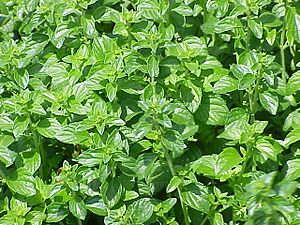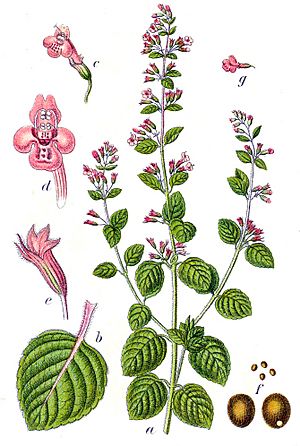Lesser calamint facts for kids
Quick facts for kids Lesser calamint |
|
|---|---|
 |
|
 |
|
| Scientific classification | |
| Genus: |
Clinopodium
|
| Species: |
nepeta
|
| Synonyms | |
|
|
Lesser calamint (also called Clinopodium nepeta) is a small, green plant that belongs to the mint family. It's known for its fresh smell, which is a mix of mint and oregano. This plant is often used in cooking, especially in Italian and Corsican dishes.
Contents
What Lesser Calamint Looks Like
Lesser calamint is a plant that grows back every year. It forms a neat, round shape with shiny, green leaves that look a bit like oregano. When it blooms, you'll see pretty lavender-pink flowers.
This plant can grow up to about 18 inches (45 centimeters) tall. It has a unique smell, like a blend of mint and oregano. Bees and butterflies love to visit its flowers.
Growth and Life Cycle
Lesser calamint usually grows during the summer and well into the fall. When winter comes, it might go to sleep, or become dormant. This means it stops growing and rests until spring. In spring, it will start to grow and blossom again.
In the fall, after the flowers fade, their seeds drop to the ground. These seeds can then grow into new plants all by themselves. New plants that sprout from seeds will start to flower in late August.
You can often find lesser calamint growing wild. However, it also grows well in pots in gardens. A lesser calamint plant usually lives for about 3 to 4 years. Sometimes, it can get a plant disease called powdery mildew, which looks like white powder on the leaves.
How Lesser Calamint is Classified
The lesser calamint was first described in 1753 by a famous scientist named Carl Linnaeus. He gave it the name Melissa nepeta. Over time, scientists moved it to different plant groups, like Calamintha and Thymus. Today, most scientists agree it belongs to the Clinopodium group.
How Lesser Calamint is Used
Lesser calamint is a popular herb in cooking, especially in Corsican and Italian food. In these places, it has different names like nepita, mentuccia, nipitella, or nepitella.
In southern Italy, people use it to make a special goat cheese called cassiedu. The lesser calamint gives the cheese a fresh, minty taste. Some people believe that a different plant, Nepeta nepetella, is the true "nepitella" used in cooking.
In a region of Spain called Galicia, lesser calamint is used with other herbs to add flavor to boiled chestnuts.
See also
 In Spanish: Clinopodium nepeta para niños
In Spanish: Clinopodium nepeta para niños

